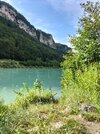Paul Bullinger
Senior Member & Supporter
A week ago my wife and I were in Scotland as she was running in the Loch Ness Marathon (rather more brutal than she expected!!)
Anyway, we stayed up there for a few days to look around. The rivers were impressive. Many had fast sections but with areas of slack water. They seem ideal for barbel but they aren't found up there. Is it purely due to them not being introduced or is there another factor?


Anyway, we stayed up there for a few days to look around. The rivers were impressive. Many had fast sections but with areas of slack water. They seem ideal for barbel but they aren't found up there. Is it purely due to them not being introduced or is there another factor?



